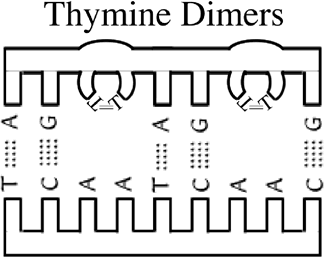THE VIRTUAL EDGE: Lab 8 Control of Microbial Growth I |
|
LETHAL EFFECTS OF UV RADIATIONUV light has a short wavelength (~10 to 400 nm). UV has a lethal effect on most organisms primarily because of its ability to cause the formation of thymine dimers in DNA. Thymine dimers are two adjacent thymine bases that are abnormally linked together by covalent bonds. This dimerization inhibits DNA replication, which may lead to death of the organism.
Dimers form bumps in the DNA and disrupt the hydrogen bonding between bases on the complementary strands. Since UV light exerts a lethal effect on bacteria it can be used to sterilize various objects such as benches, surfaces of foods, utensils, etc. Because UV light has very little penetrating power it is only used for sterilization of surfaces. Because mutations such as thymine dimers are potentially life threatening, cells have a number of systems for finding and repairing damaged DNA. There are two primary mechanisms generally used for repair of UV damaged DNA. The first mechanism is called photoreactivation (light repair) and the second is generally termed excision repair. As excision repair takes place in the absence of light, it is also sometimes called dark reactivation.
1 More about this enzyme: Cell. 1983 May;33(1):249-60. |
|
| Lab 8 / Lethal Effects of Ultraviolet Radiation / Antimicrobial Sensitivity: Kirby Bauer Technique / Isolation of Drug Resistant Mutants / Lab 8 Organisms Please take a few minutes to fill out a brief survey about your experience using the Virtual Edge: https://docs.google.com/forms/d/1yGbkF0KM92WBSk-IgS-EkjxkTKTQwhzuXmDsVpwRDoU/viewform Please email comments/problems to cboggs@uwyo.edu |
|
Rachel Watson, M.S. |
|

The Virtual Edge by http://www.uwyo.edu/virtual_edge/ is licensed under a Creative Commons Attribution-Noncommercial-Share Alike 3.0 United States License



